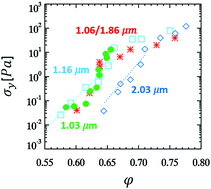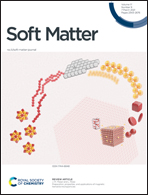Rheology finds distinct glass and jamming transitions in emulsions
Abstract
We study the rheology of monodisperse and bidisperse emulsions with various droplet sizes (1–2 μm diameter). Above a critical volume fraction ϕc, these systems exhibit solid-like behavior and a yield stress can be detected. Previous experiments suggest that for small thermal particles, rheology will see a glass transition at ϕc = ϕg ≈ 0.58; for large athermal systems, rheology will see a jamming transition at ϕc = ϕJ ≈ 0.64. However, simulations point out that at the crossover of thermal and athermal regimes, the glass and jamming transitions may both be observed in the same sample. Here we conduct an experiment by shearing four oil-in-water emulsions with a rheometer. We observe both a glass and a jamming transition for our smaller diameter droplets, and only a jamming transition for our larger diameter droplets. The bidisperse sample behaves similarly to the small droplet sample, with two transitions observed. Our rheology data are well-fit by both the Herschel–Bulkley model and the three component model. Based on the fitting parameters, our raw rheological data would not collapse onto a master curve. Our results show that liquid–solid transitions in dispersions are not universal, but depend on particle size.



 Please wait while we load your content...
Please wait while we load your content...